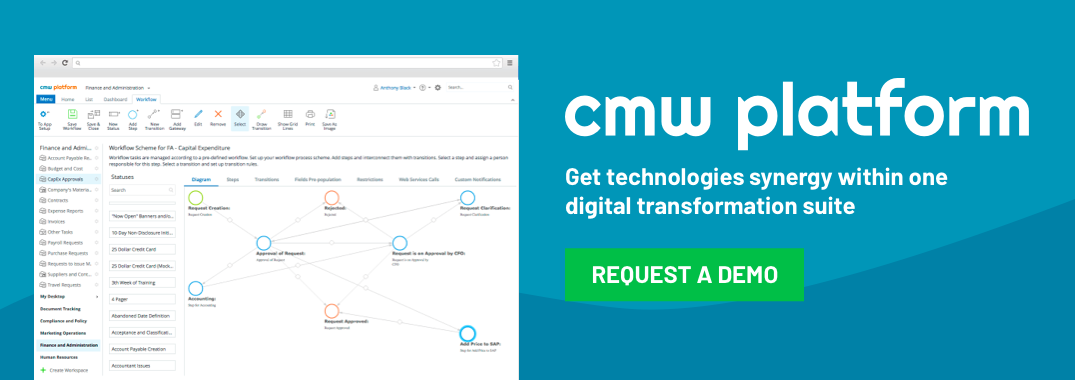The workplace is no longer a hive of cleanly divided roles with disparate responsibilities. Companies are finding themselves at a disadvantage when they exclusively relegate project management to a single project manager whose workflows and methodologies are separate from the rest of the organization. Project stakeholders end up holding different pieces of information in different silos with no clear way of bringing it all together. Recent data shows that 37 percent of employees feel there isn’t enough collaboration in their workplace.
The new era of PM software seeks to remedy this problem by integrating powerful collaboration tools alongside traditional PM features that enable a team-based approach to project management. A small handful of more innovative vendors are leading the charge toward enhanced project collaboration, but you can expect some of the following features to standardize as innovation catches on.
The Cloud
First of all, countless PM vendors are making the transition to offering cloud-based services—some exclusively, others in addition to their on-premise system. The cloud has been around for a while now, and software companies are capitalizing on the versatility of web-based software-as-a-service (SaaS) to enable better collaboration and mobility.Many employees now work on the go or remotely. They access company resources on mobile phones, laptops, and tablets. Many companies even employ remote or overseas talent to manage projects for a specific term. While on-premise PM software can be powerful in its locale, it costs more up-front and offers less flexibility in the long run. The cloud makes PM resources and seamless collaboration available anywhere, at any time.
Document Sharing
Most businesses agree that document and file sharing via email is less than efficient due to the added workflow steps of having to open a separate email program, find the email, download the attachment, save it to your computer, and upload it again with your response or edits. But many of those same businesses have settled for third party file sharing applications like Google Drive and Dropbox without realizing they’re only adding yet another system to the mix.This is why the PM suites of the future will integrate their own file sharing. Project players can share invoices, reports, and documents from within the PM software itself, which removes unnecessary steps and reduces inbox clutter. Integrated file sharing gives everyone access to the same information.
Social Enterprise Tools
The integration of social media-style feeds and updates are a natural extension of recent trends in customer relationship management and engagement. In order to fully capitalize on a relationship, you have to be willing to pursue and monitor it as it occurs in various channels (as opposed to a few predetermined channels, such as by email or phone). Similarly, project management that involves collaboration doesn’t create a hierarchy, but rather an ecosystem in which all parts are constantly connected and interacting.To make sure you’re capitalizing on the knowledge and participation of every stakeholder, you have to make them privy to the stream of project dialogue in real time. Think of it as useful eavesdropping: an employee overhears a conversation about a topic on which they are knowledgeable, and their human instinct to “pitch in” moves them to speak up and offer insight. Same concept.
Newer PM solutions are also offering integrated communication features such as chat, instant messaging, and email synchronization—again, so users can connect within the system, under one umbrella, about project issues and insights.
Advanced Reporting/Analytics
When communications and data exchange are all happening in the same place, it makes it a lot easier to draw insight from the data. The new age of PM software will provide advanced reporting and analytics tools so project managers can track progress in real time and make decisions about resources, bottlenecks, and priorities.In a PM climate that is becoming increasingly “agile” and iterative, these real time insights will prove invaluable. Comindware’s predictive Gantt feature is a good example of smarter analytics. Not only does the chart update itself, it also shifts unfinished work into the future and makes projections about future progress. You can base task-management decisions on real, up-to-date data about stakeholders’ involvement, rather than on guesswork.
The evolution of PM analytics is also promising for risk assessment practices. With traditional PM, risk assessment primarily happens on the front end, and by the time your team is months into a project, the original projections are often irrelevant. The most competitive PM solutions will let you assess and reassess your project’s risk at any time, leading to a fluid understanding of what’s at stake for the company.
*
Project management—the art and the science—will always boil down to a company’s ability to perform under pressure. The pressure won’t ease, and neither will the onus to perform. But that doesn’t mean businesses shouldn’t nurture creative ways to get the most out of their projects. The new wave of fully integrated project management software is bringing it all under one roof, where contributors will collaborate, make decisions, and accomplish goals in the most efficient way possible.
